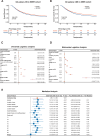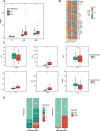Bone Metastasis Mediates Poor Prognosis in Early-Onset Gastric Cancer: Insights Into Immune Suppression, Coagulopathy, and Inflammation
- PMID: 40040540
- PMCID: PMC11880774
- DOI: 10.1002/cam4.70737
Bone Metastasis Mediates Poor Prognosis in Early-Onset Gastric Cancer: Insights Into Immune Suppression, Coagulopathy, and Inflammation
Abstract
Background: The increasing incidence of gastric cancer (GC) in younger populations, coupled with population aging, has highlighted distinct age-related subtypes with unique clinical characteristics and outcomes. Although younger patients tend to have more aggressive tumors, the prognostic factors for early-onset gastric cancer (EOGC) remain underexplored. This study is dedicated to providing a comprehensive and in-depth analysis of prognostic factors in EOGC, aiming to refine personalized treatment strategies under the precision medicine paradigm.
Methods: This retrospective study encompassed 413 local cohort EOGC patients and 8447 Surveillance, Epidemiology, and End Results database patients diagnosed with GC. Survival outcomes were assessed using Kaplan-Meier survival curves, and differences between groups were evaluated with the log-rank test. Prognostic factors were identified through logistic regression and Cox proportional hazards models. Mediation analysis was conducted to assess the indirect effects of clinical factors on EOGC and prognosis. Biomarker comparisons between bone metastasis early-onset gastric cancer and non-bone metastasis early-onset gastric cancer groups were evaluated using the Wilcoxon test for significant differences.
Results: The overall survival and cancer-specific survival rates in the EOGC group were significantly lower than those in the non-early-onset gastric cancer group (p < 0.05). However, EOGC itself was not an independent risk factor for poor prognosis. Mediation analysis revealed that the adverse impact of EOGC on prognosis was predominantly mediated by metastasis, with bone metastasis identified as the most significant factor. Furthermore, bone metastasis emerged as an independent predictor of poor prognosis in EOGC patients, potentially linked to elevated coagulation markers, increased inflammation-related cytokines, and an imbalance in peripheral blood immune cell ratios.
Conclusions: Bone metastasis significantly contributes to the poor prognosis of EOGC. EOGC patients with bone metastasis demonstrate immune suppression, inflammation activation, and coagulopathy, highlighting the need for tailored management and prognostic strategies.
Keywords: bone metastasis; early‐onset gastric cancer; mediation analysis; prognosis; survival analysis; cytokines.
© 2025 The Author(s). Cancer Medicine published by John Wiley & Sons Ltd.
Conflict of interest statement
The authors declare no conflicts of interest.
Figures




References
-
- Takatsu Y., Hiki N., Nunobe S., et al., “Clinicopathological Features of Gastric Cancer in Young Patients,” Gastric Cancer 19, no. 2 (2016): 472–478. - PubMed
MeSH terms
Grants and funding
LinkOut - more resources
Full Text Sources
Medical
Miscellaneous

